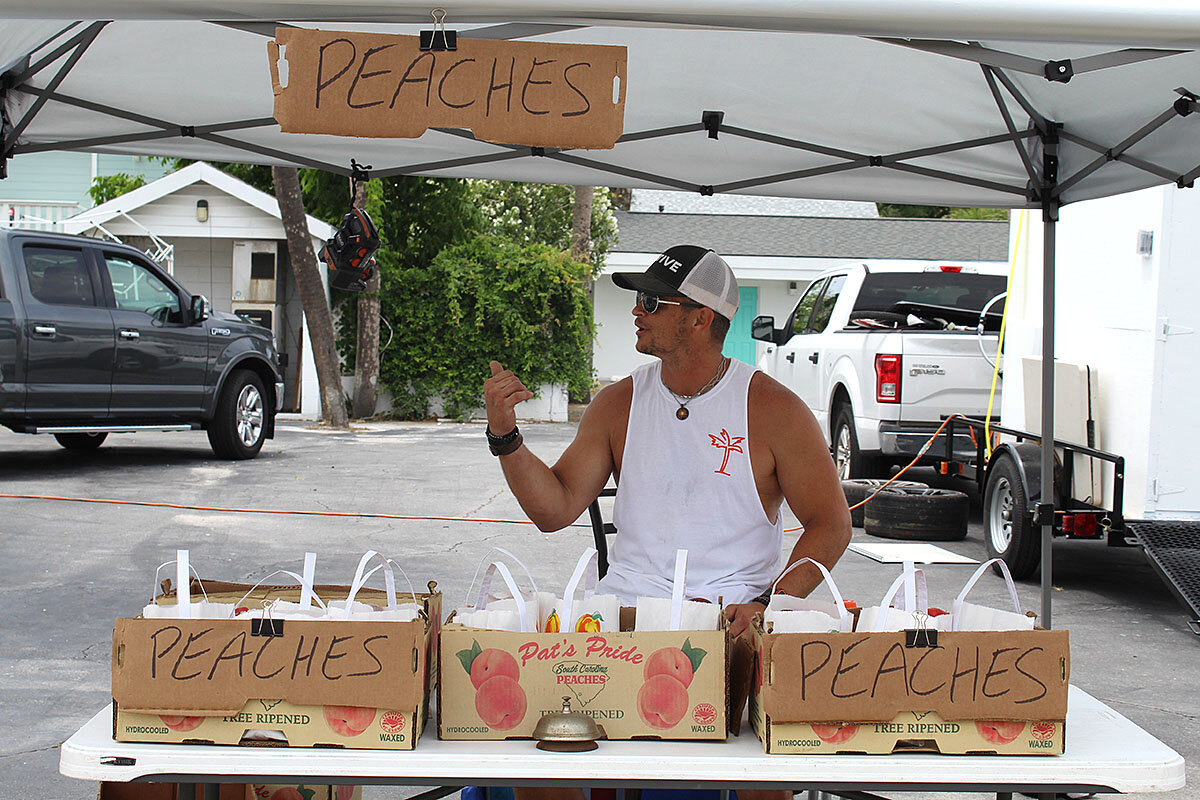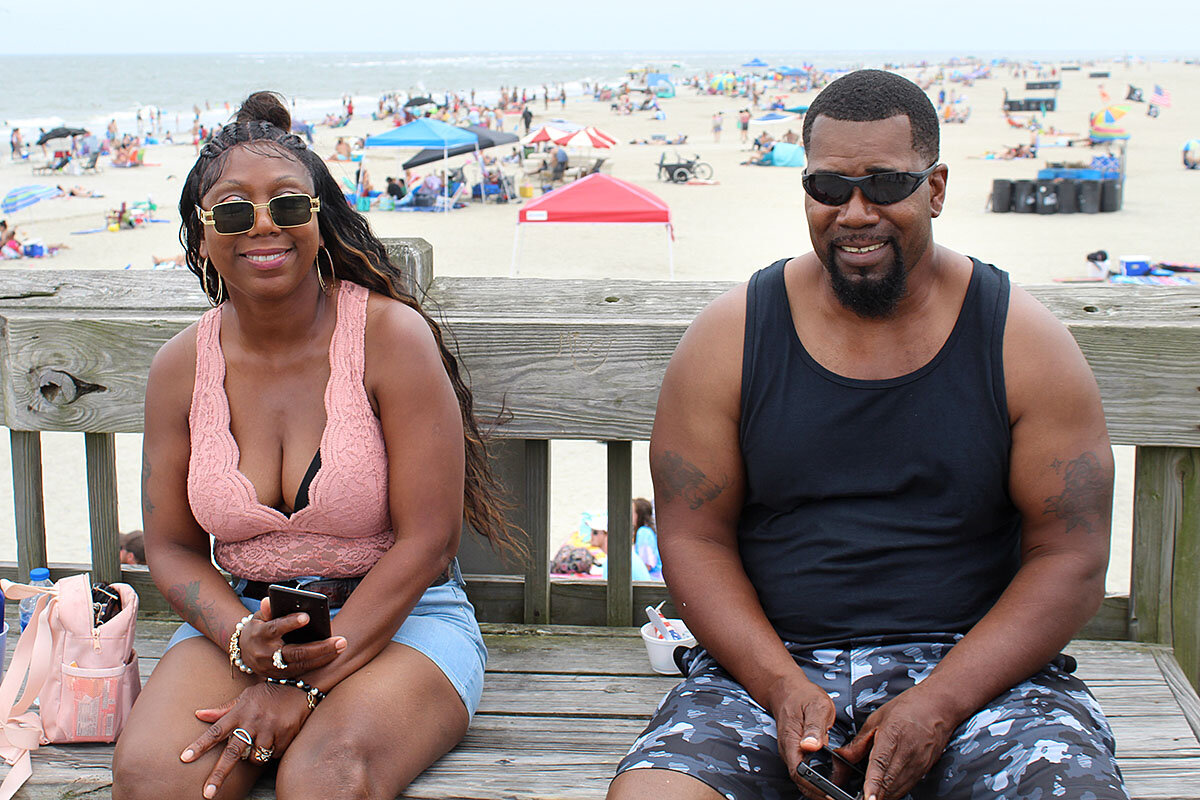As Georgia reopens, is it creating a model for America?
Loading...
| Tybee Island, Ga.
Georgia peach broker Brandon Jones was hoping for a banner weekend.
He thought peaches on Memorial Day in Georgia would be a sure sellout, so he brought 20 boxes to Tybee Island, which exploded with people over the holiday weekend as the United States began to reopen.
But his peach sales were far off despite the crowds. He took the profit problems instructively – as a symbol of an America cautiously stepping out from under pandemic restrictions.
Why We Wrote This
Georgia’s rapid reopening one month ago had many officials predicting a new spike in cases. So far that hasn’t happened. Why not, and what clues could the state hold for the rest of the U.S.?
Also on display: the challenge ahead. Local customers at a farmers’ market in nearby Savannah nearly all wear masks. But perhaps 1 in 100 tourists at Tybee Beach did on Monday as a T-shirt that said “I survived the 2020 pandemic” hung from the rafters at the grocery store.
“I’m worried that locals take reasonable precautions, but tourists may come here and say, ‘Georgia’s open, let’s go!’” says Mr. Jones.
Editor’s note: As a public service, all our coronavirus coverage is free. No paywall.
The fact that Georgia so far seems to be bucking the consensus that its rapid reopening of businesses exactly one month ago would result in disaster has been widely noted. The Wall Street Journal dubbed it the “Georgia Model.”
“What we’re starting to see is there’s a lot of financial and economic pain in the country, and quite frankly people are starting to wrestle with the very ugly decision about how much death and real sickness are we willing to tolerate to get people back to work so they can pay their rent and feed their families,” says Gregg Murray, a political scientist at Augusta University in Georgia.
“There is no normal”
A former soldier who has lost several friends to the virus, Wayne Dukes is definitely wrestling as he watches the crowds walk by on the Tybee pier.
“There is no normal, that’s gone,” says Mr. Dukes, a Savannah resident. “Everyone is figuring this out. And a lot of it depends on where you live and who you are.”
Across the country, the holiday weekend brought tens of thousands out as all 50 states began lifting pandemic restrictions last week.
That has resulted in some modest economic improvements, but in Georgia, where restaurants have been able to operate for three weeks, dine-in traffic is about 12% compared with a year ago.
Those numbers show that, despite a packed pier on Tybee Island and much-publicized scenes of mobbed pool parties over the Memorial Day weekend in Texas and Missouri, many Americans are taking a cautious approach to reopening.
That hesitancy may have helped, public health officials say. Georgia’s rolling seven-day average of new cases has declined, according to the Department of Public Health, down from nearly 728 on May 19 to 308 on May 25. Other tallies show the number of cases running flat, despite an increase in the state’s testing rate. That improvement comes as Georgia state officials apologized last week for adding faulty data that made its decline look more pronounced, citing a processing error. And in neighboring Florida, data scientist Rebekah Jones, who handled the state’s COVID-19 dashboard, claims that she was fired for refusing to fudge numbers in order to support the state’s reopening plan.
Texas, Arizona, Alabama, and North Carolina have seen spikes amid reopening, even as the numbers in the epicenters in New York and New Jersey are falling as those states more slowly ease restrictions.
Modelers worry about an uptick in Southern states, but acknowledge that there are huge X factors – including whether hot weather might help hold down the spread – that are playing out in places like Tybee Island, which saw an estimated 80,000 people descend on its 3 square miles over the Memorial Day weekend.
“Policy matters, but what matters even more is personal behavior,” says Kent Smetters, a modeler at Penn Wharton Budget Model, which predicts COVID-19 infections across the U.S. “Suppose that these people view these partial reopenings as a kind of social cue ... that things are OK, and as a result they reduce their own personal social distancing, then the [mortality] effect is bigger.”
Some of those interviewed, like Mr. Dukes, expressed concern about the extent to which leadership and partisan politics have colored the U.S. response to a pandemic that has so far claimed nearly 100,000 American lives.
After all, the top six of the seven hardest-hit states are blue states. Massachusetts, No. 3, is run by Republican Gov. Charlie Baker. Texas, where cases are increasing, is seventh. Those blue states – which share high population density, colder weather, more public transportation – have about half of all cases, but only a third of the nation’s population.
How partisan is the decision-making?
Yet so far, the state-led response appears to have focused on public health. Most governors have seen their approval ratings soar, with Ohio Republican Mike DeWine at No. 1. Governor DeWine shut his state down quickly, was the first to send schoolchildren home, and has defended his public health officials against partisan protesters.
In a study of 785 executive orders from March 6 to May 11, researcher Maryann Feldman found that “a partisan lens does not provide much additional insight” into state responses. Partisanship may play a larger role going forward, however, she says.
“The fact that we saw many of the governors who don’t have to care about reelection issue more orders suggests that [political leaders] are feeling constrained by their electability,” says Ms. Feldman, a public policy professor at the University of North Carolina, in Chapel Hill. “We have to keep stressing that this is a public health problem, not a political problem.”
On Friday, Vice President Mike Pence touched down in Atlanta to meet with Gov. Brian Kemp, who has received low marks for his handling of the pandemic. Yet despite a series of missteps, there are signs that his gamble to limit restrictions despite several heavy outbreaks may have paid off.
What’s behind a model whose success bucks conventional wisdom? Some experts point to the heat, and the humidity. “The weather would be my answer,” says Michael Levitt, a Stanford biophysicist who is tracking the virus, in an interview.
“Be like Sweden”?
And for researchers looking at the dynamics of a possible resurgence, one question is at the heart of what’s happening here and beyond: Will Georgia be America’s Sweden? And what does that mean?
“Be like Sweden” flags have flown over anti-lockdown protests in the U.S. The Scandinavian nation kept restaurants and public schools open while relying on citizens’ judgment to contain the virus. While it has escaped the massive death tolls of the U.S., United Kingdom, Italy, and Spain, it reached the highest per capita death rate in the world last week.
“Sweden really had very few lockdowns, but people also interpreted that as we have to be personally responsible and maintain a fair amount of social distancing despite some of the restaurant scenes,” says Mr. Smetters. “But that is a very different culture, and it may be easier for them since Swedes [tend to be] socially distant” culturally.
At least one Georgian is determined to adopt that model, at least in spirit.
“I’m bracing” for a wave of new cases, says Mr. Dukes, the Savannah soldier. “I hope I’m wrong. But we also can’t live our lives in fear.”
Editor’s note: As a public service, all our coronavirus coverage is free. No paywall.








